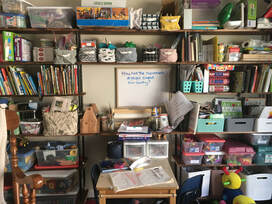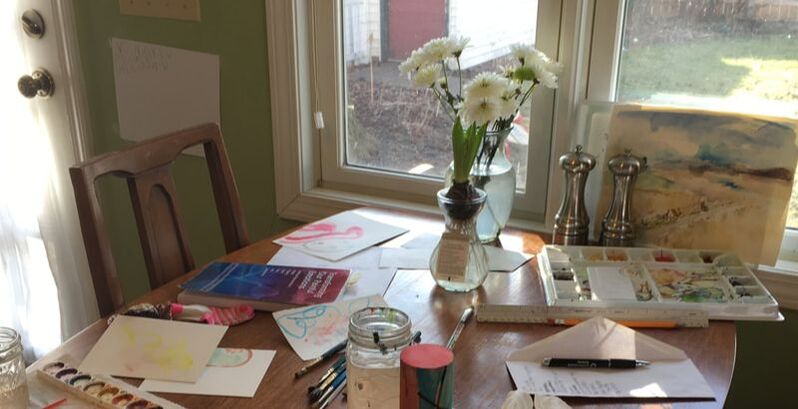|
I stepped away from my annotated bibliography project for awhile. I have time blocked out for research, since I teach on campus one day a week spring semester, and between those writing projects and class prep, all my reading has revolved around methodology, reconciliation, and (surprisingly) complex systems theory. I have been annotating and mapping this reading journey, but it is another writing for another day. **And now that university has shifted online and daily life remains relatively confined to the home, rendering this post (drafted a few weeks ago) even more timely.
A guest speaker in my research class, a historian of art education, was sharing about all the spaces where art education happens. Some of his work has focused on the role that department stores have played as art educational spaces, and his interest is in the “other” spaces where learning in the arts happens: movies, sci-fi, popular culture, etc. and he used the phrase at one point, “Pedagogy of the Home.” Deep exhale.
0 Comments
 Dear Parents, Who are Homeschooling for the First Time, I hear you. You are now (for the next few weeks) solely responsible for the growth, development and education of your child. It’s hard. It’s hard to balance the expectations placed on you by just about every facet of society and the realities of your home and work life, exacerbated by everything in your life changing by the hour. I feel for the teachers, scrambling to adapt their curriculum to new spaces and trying to maintain some semblance of continuity for their students. I know they worry about their students, as I do for mine. I feel for the students who are now adjusting to new routines, new structures, and new responsibilities that they perhaps are not equipped to handle. I feel the structural inequalities, which are highlighted in times like these and shape the daily lives of so many children and families. There is opportunity here, though, to get creative about the ways we are connecting, the ways we are educating, the ways we are serving one another. I cannot address all these issues, but I can speak to education at home. The one thing I do know is school at home is not public school. I see many posts about parents trying to implement block scheduling or replicate the preschool schedule of circle time, craft time, exercise time, etc. Maybe that works for your family. Great! For me, despite my love of planning curriculum and designing courses, those types of schedules set me up for failure. I stress. I fail to maintain the schedule for more than a few days. And I feel like I’m letting down my children, like I’m not giving them enough. But, let me describe what works in our home. It is a practice of letting go (mostly me) within structure. I will preface this by saying I work full-time from home, teaching online and doing some consultant work for churches. I squeeze in this work whenever I can, and sometimes we make compromises (on my work or my kids’ school). I have a curricular plan. Like I said, I LOVE planning out the whole year, roughly marking out the time spent on projects. I love designing projects, collecting the supplementary materials, finding videos, instructions, books. I love making packets, and I have a child who really loves packets. Typically, my packets are for history and science subjects, and then we use a workbook series for math and language arts. We work on these once or twice a day for anywhere from 30 minutes to 2 hours, depending on the level of concentration and whatever else is going on. But, I frequently have to let go of my plans, change what I think will work, and trust my intuition and my children's learning processes. I find myself (not as often as I should), stepping back to remind myself that I want my children to be good human beings, who love their neighbors, love God, and love to learn, because learning helps us to better take care of each other and the world around us. So, I adjust the focus of our time together. It is less about completing tasks (but, oh, how I love checking off to-do lists. And, I keep them habitually and daily) and more about what type of space I'm creating for the kids. A pedagogy of the home (more on that to come). I make sure they get outside and they get time to work on whatever projects they are in the middle of (right now, we’re on day three of some intensive Lego building, both with little sets and the Duplo’s). I’m all for giving kids space to make in whatever capacity they want. They learn so much on their own, if they have time, space, and a few materials for it. I keep books around, and we read together (not nearly enough according to all the info charts floating around social media). We listen to podcasts during lunchtime. Sometimes it’s a few chapters of an audio book (We’re currently in the middle of House at Pooh Corner, Wizard of Oz, and Big Nate), and sometimes it’s the Kids Bible Story or Classical Kids Storytime podcasts. Sometimes it’s just music. I keep music on in the background throughout the day, changing the type of music depending on how intense the kids’ energy is (and how much calming I need). The kids have access to craft supplies. For someone in art education, I am terrible at doing structured art projects and craft projects with the kids. But, we do pull out the paints, paper, colored pencils, string, magazines, or whatever frequently to make things. Sometimes we sit all together making something, and sometimes the kids just pull them out at their little table. There is constantly a mess of supplies lying around the kitchen table and drying projects jamming up pretty much every horizontal surface. My patient husband bought me a drying rack for my birthday, which is currently jammed full with projects and the clutter begins again. We go through phases. It was watercolor for a couple of weeks. Then, colored pencils. Right now, we’re doing basket weaving. We have a rhythm to the day, rather than a schedule. That rhythm changes with the weather. If it’s nice out, we spend more time outdoors. It’s also determined by the baby’s naptime. I do work (the kids and my own) while she is sleeping. More accurately though, the daily rhythm becomes a weekly, seasonal rhythm, responsive to the time in the university semester (and other work demands), current events, family events, basically life. And boredom is ok. To be honest, my oldest has only made that “I’m bored” comment a handful of times, despite the fact that he's almost 8. And then he wanders off and finds something to do. Or, he lays down for a while. Most of the time, they move between playing on their own (which is, I cannot stress enough, as much active learning as anything else), helping me in the kitchen, working together, or spending time outdoors. It’s punctuated of course with what seems like incessant bickering or complaining about doing workbooks instead of whatever strange (to me) project has been concocted (today, it’s soaking a handful of wild spring onions in a bucket of water with pepper sprinkled on the top) and the resulting negotiation of how our time will be spent for the next five minutes. But, I would not trade this rhythm for anything. What I would say to you, parents, is to think about your rhythm, not your schedule. And give yourself some grace and your kids (and yourself) some space to learn and live in a different way together. Bake together. Let your kid make everyone lunch (it might not taste great, and it will probably be really messy). Let them only do one line of math (that happened today) and then two hours building something out of Legos. They're learning and building really important skills like focus, which will benefit that math worksheet later. Make a mess (and clean it up tomorrow). Give yourself permission to fail at being a classroom teacher, because that is not who you are and not who your kids need you to be. They just need you, and whatever rhythm works for your family. I’ve been mulling over an idea: reconciliation as research paradigm.
Something about the process of reconciliation has stuck with me. Over the past few weeks, I’ve been reading various combinations of “reconciliation theology” “PAR and reconciliation” “research methodology and reconciliation” and “art education and reconciliation”. In the articles about reconciliation in research so far, most of what I’ve read has had to do with doing research in a different way. Especially interesting have been researchers in the quantitative paradigm working with indigenous communities, dealing with the fact that our history as researchers is entrenched in an institution shaped by colonization, racism, and a general attitude of dominance over ways of thinking, being and doing different than white, western, scientific thought. As indigenous researchers develop methodologies and bodies of research rooted in their own epistemologies and as non-indigenous researchers learn to come alongside in ways that value and respect them, how do we move forward together? In many of these articles, reconciliation is a principle, a part of a new approach to this sort of research. But, what if we centralize reconciliation? What does that make space for? What possibilities does it open? What questions does it raise for researchers – who we are, what we do, and how we do it? How does it change the aims of our research? How does it alter our practices, our questions, our methods, our publications? |
Ruth M. SmithCommunity arts educator and researcher. Drinking coffee. Home educating. Making art. Listening intentionally. Categories
All
Archives
February 2022
|

 RSS Feed
RSS Feed
